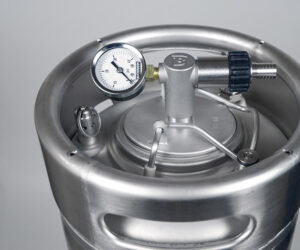Open Fermentation: Tips from the Pros
Brewer: Alan Kornhauser
Brewery: Portland Brewing Co.
Years of experience: 23
Education: Brewing and malting courses at the United States Brewers Association; microbiology certificate from Siebel Institute of Technology; other professional courses
House Beers: MacTarnahan’s Amber Ale, Original Honey Beer, Zigzag Lager, Haystack Black Porter
The basic benefit of open fermentation is that there is no pressure on the vessel. The benefit of no pressure is that the yeast will work better. The higher the pressure the slower the fermentation. Pressure tends to retard the yeast metabolism. Lack of pressure gives you a higher percent of live cells, resulting in quicker fermentation.
The other real advantage is that you can see how well your fermentation is going. You learn to know how your fermentation is supposed to look. If it doesn’t look like what you’re used to, you know something is wrong.
Open fermentation also reduces your risk of volatiles. Sulfur dioxide levels are an issue in producing beer. If you have beer trapped in a tank, all those volatiles that are produced tend to be retained in the tank and stay in solution a lot more. When exposed to the atmosphere in an open fermenter, those volatiles have a place to go. Whatever it is you’re producing that’s undesirable, you have a much greater chance of driving it off than you do in a closed fermenter.
Why doesn’t anyone do this in the real world? Because the fermenters are hard to clean. You have to do them by hand. If you put a spray ball inside your open fermenter, your caustic solution is going to fly all over the room and in your face. Obviously with a closed tank you cycle it through with a pump.
The other major drawback is the chance of contamination. To reduce chances of contamination, you should probably filter the air that goes through the room. This is difficult if you are homebrewing. You should just ferment in a room that is very, very clean. If you are going to do it in a basement that is full of mold, that mold flavor is going to end up in your beer. Be very conscious of mold growth on the walls, floors, and ceilings. Scrub the ceiling, preferably with bleach. Sometimes people forget to look up and see what the ceiling looks like. It’s also important for the fermenter to be in an area with adequate ventilation. Ventilation will help reduce contamination and prevent the buildup of carbon dioxide and volatiles that escape during fermentation.
The best container to use is one that is not porous at all so that it is easy to clean and won’t retain bacteria. Shape will affect fermentation. Anheuser-Busch has done a tremendous number of studies on shapes of fermenters vs. the flavors they get. (A-B doesn’t) feel they can get the same flavors out of different shaped fermenters. The greater the depth of the fermenter, the higher the pressure on the yeast at the bottom of it. So you get some of the problem of pressure. The more shallow the fermenter, the fewer problems you have. In an ideal world you’d want a completely round fermenter. Then you wouldn’t have any corner surfaces that would be difficult to clean. But for a homebrewer it’s not really an issue because you are using such small quantities. Glass would be the easiest surface to clean. We in the brewing industry love stainless because of its inertness — it won’t impart flavors — and its ease of cleaning. If you ferment in mild steel, your beer will taste like a bucket of nails.
Different shaped fermenters tend to produce different looking fermentations. If there’s a trough in the bottom of the fermenter, this trough is mirrored by a bump in the foam on the top of the fermenter. It is not a good or a bad thing; it’s a thing. You just want to get to know what your fermentation looks like.
Another aspect to keep in mind is aeration. You can get by with splashing the wort as it goes into the fermenter and causing it to bubble. It’s not a good practice because of the other bad things you’ll do to the wort. Every time you make the beer foam, that’s less foam you’ll get in the glass. We inject sterile air into the line as it’s going into the fermenter. Aerating the wort is critical to making yeast that’s going to ferment well the next time. If you’ve got yeast that has been aerated well, you don’t need to aerate the wort. It will ferment one time, usually pretty well, without aeration. If you subsequently try to collect that yeast to get it to ferment after that, good luck. The problems of aeration are cumulative.



